STEAM Studio's STEAMcation Students Visit RailTEC...Learn All About Trains
August 17, 2016
Remember the excitement you felt as a youngster when you heard the shrill whistle of a train in the distance? Remember the magic of sitting at a railroad crossing, watching a train zoom by, waiting to shout, “The caboose!”?
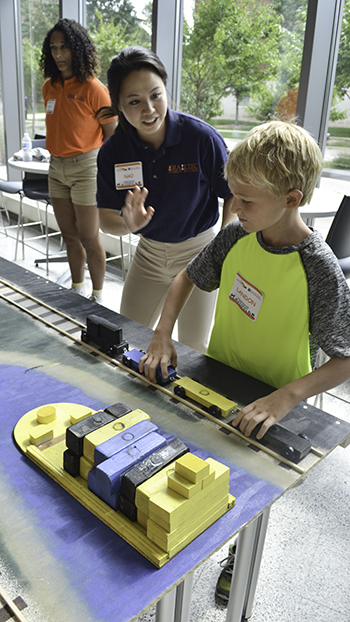
Grad student Nao Nishio (center) explains to a student how trains with many cars can carry products more efficiently and economically.
Knowing that trains still engender excitement in youngsters, at RailTEC, Illinois’ Rail Transportation and Engineering Center, staff and students tap into youngsters' love of trains to teach them some STEM principles. And on August 3, 2016, a group of 24 local 3rd through 5th graders from STEAMcation, STEAM Studio’s 9-week summer program, visited RailTEC and experienced it firsthand. They spent the day learning about railroads; did a variety of fun, yet educational, hands-on activities related to railroads; plus had the chance to interact with some great role models—real, live engineers, who shared their passion for railroads and engineering with the youngsters.
The trip to RailTEC was the pièce de résistance of STEAMvention week, the final week of STEAMcation, the 9-week summer STEAM (Science, Techology, Engineering, ARTS, & Mathematics) program of Next Generation School’s after-school and summer program for elementary students, STEAM Studio.
For the outreach, RailTEC faculty and students, in collaboration with the STEAM Studio Director, Angela Nelson, came up with numerous creative, hands-on activities related to trains that students found both fun and educational.
For instance, during the Intermodal Game, students learned an object lesson in economies of scale. A wooden train with several cars loaded with materials can transport them more quickly, more safely, and with less expenditure of energy than individual trucks making individual trips to transport the same amount of material.

RailTEC Ph.D. student Brandon Wang (right) watches a student "build" a railroad track.
A RailTEC graduate student Nao Nishio, who helped out with the Intermodal Game, explains why she got involved with the outreach.
"I love railroads, studying railroads," she admits. "and I’m also a grad student for Rail Tech, and I definitely wish I had the experience they had when I was younger. I got into it in college, where I met Dr. Barkan teaching the class and all that. I’m hoping they get inspired and go into the STEM field or the STEAM field."
During the “Railway Track Design and Construction” activity, students used various components to build a replica of train track from scratch. Railroad ties were topped by rails (which were securely held in place using colored push pins), placed atop a bed of sand then topped with a layer of gravel. The students used spring scales to measure the resistance of track to movement. Besides learning the basic structural design of the track system, they learned to use measurement tools, record data, and to analyze the results to help them understand how the track system actually works.
Arthur De Lima, a graduate student conducting research on improved track designs, helped with the railway track building activity.
He called the event "a fun opportunity to teach kids what we do here—share the knowledge. When you look at a track, not many people know what’s going on beneath the surface, how you build it, and how you operate over it. It’s to show the kids how it actually functions, and seeing their excitement is always fun."
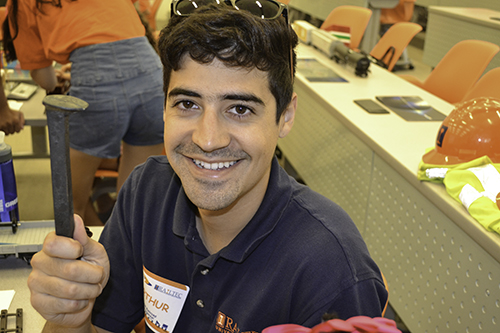
Arthur De Olivera Lima exibits an actual railroad spike; for his activity, students used push pins as miniature rairoad spikes.
The activity, which was completely hands-on and involved building a track from start to finish, appeared to be extremely effective in teaching the children about tracks.
"I think the hands-on aspect helps them understand," says DeLima, "because if you’re showing pictures and things, they might not be paying too much attention, but if they’re working and building their own track, it gets them to understand what’s going on."
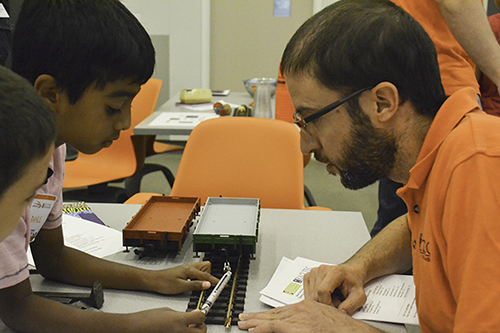
RailTEC grad student Alejandro Reyes (right) teaches two students about roller resistance.
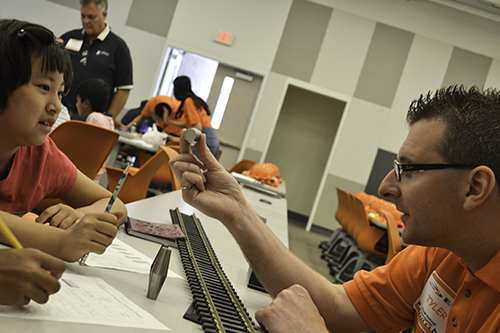
Tyler Dick (right), a senior research engineer and Director of Education at RailTEC, does several acitivities about optimal roller shape with a STEAMcation student.
The Rolling Resistance activity involved comparing the resistance of two large model railcars that were otherwise identical, except one was equipped with metal railroad wheels and ran on track and the other had rubber tires and ran on a flat surface that simulated pavement. The students used spring scales to measure each car's resistance to movement as weight was added to the railcar. They conducted replicates for each condition, recorded the data, and then calculated averages. They used their data to draw graphs that illustrated how the cars' difference in resistance increased as more weight was added, and that the car with metal railroad wheels required less force to move because of its lower resistance.
At the Wheel-Rail Dynamics activity, students first taped together plastic cups (orange, of course, emblazoned with a railroad’s logo, no less), then tested them on a railroad track to see which of two designs would follow the track better without derailing. Then they tested smaller, metal rollers of different shapes and thicknesses on a metal track to see which worked best.
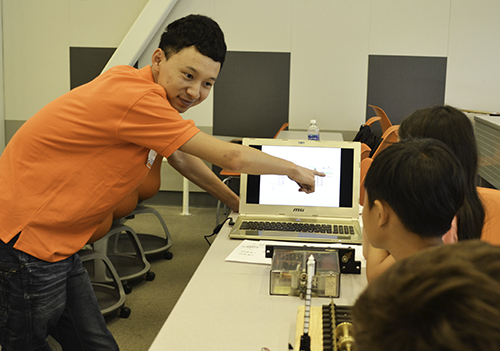
RailTEC graduate student Siyao Luan (left) explains electromagnetism to a couple of STEAMvention students
Students learned about “Electromagnetism, Railway Signals, and Railway Traction,” and actually built electromagnets using a nail, wire, and batteries. These illustrated how electric relays work and helped them understand how railway signals are controlled. At the locomotive simulator, students got to “steer” a locomotive, and even learned what the different train whistles mean (something this reporter didn’t know).
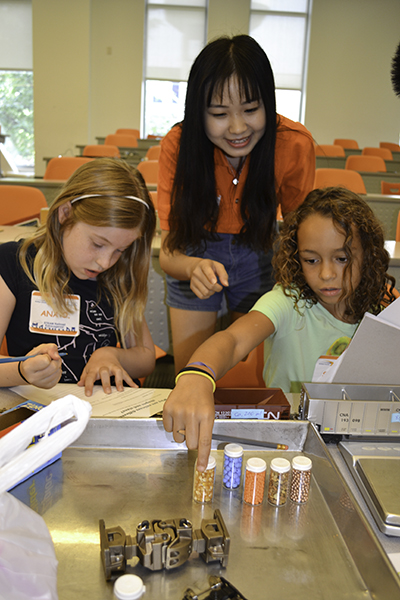
RailTEC grad student Lijun Zhang (center) assists as two students doing the “Freight Car Size and Weight” activity weigh the different products being "shipped."
During “Freight Car Size and Weight,” the young visitors learned the best designs for freight cars used to carry a products of different density. Helping out with the activity was RailTEC grad student Lijun Zhang, who says she got involved, "Because I really love kids, and I want to introduce them to some knowledge about the railway."
In addition, Operation Lifesaver, the national organization that promotes safety at railroad grade crossings, sent one of their instructors to teach about railroad safety. Students watched several live and simulated demonstrations illustrating mass and momentum and explaining why trains can't stop quickly. They were also treated to a video whose mantra was “Tracks are for trains, not for kids!””
Chris Barkan, Executive Director of RailTEC, says he and his team do outreach events such as STEAMcation's visit, first, “Because it’s the right thing to do.” Secondly, because of “the importance of STEM,” and the need to get more kids interested:
“I think most people involved in science and engineering are excited about their field and are eager to share their passion with students.”
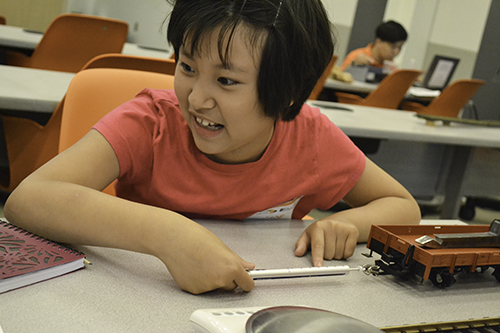
During the Rolling Resistance Measurement activity, a student takes a measurement on a railcar equipped with rubber tires.
Barkan believes his subject matter is the perfect vehicle to do so.
“We can take advantage of the special appeal railways have with many kids (of all ages) They are large, fast, powerful moving objects that easily capture one's interest. Students can "play" with these model train activities and at the same time learn STEM concepts.”
Authors: Elizabeth Innes, Communications Specialist, I-STEM Education Initiative, with Chris Barkan, Executive Director, RailTEC. Photographer: Elizabeth Innes, Communications Specialist, I-STEM Education Initiative
More:
Graduate STEM Outreach,
K-6 Outreach , Next Generation School, STEAM/SciArt, STEAM Studio, 2016
For the companion article about RailTEC, see:
For additional articles about STEAMcation and STEAM Studio, see:
- Illinois' MCBees Expose STEAM Studio's STEAMcation Students to Medieval Science
- STEAMcation Provides Summer STEAM ...With a Little Help from Illinois Friends
- Next Gen's STEAM Studio: An After-School STEM Program With a Dab of Creativity
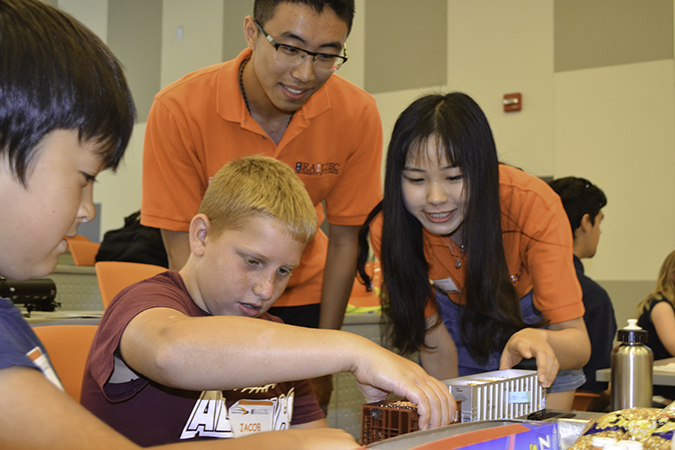
Left to right: Two STEAMcation students learn about the types of rail cars used to carry various products from RailTEC graduate students Zhipeng Zhang and Lijun Zhang.













.jpg)
















